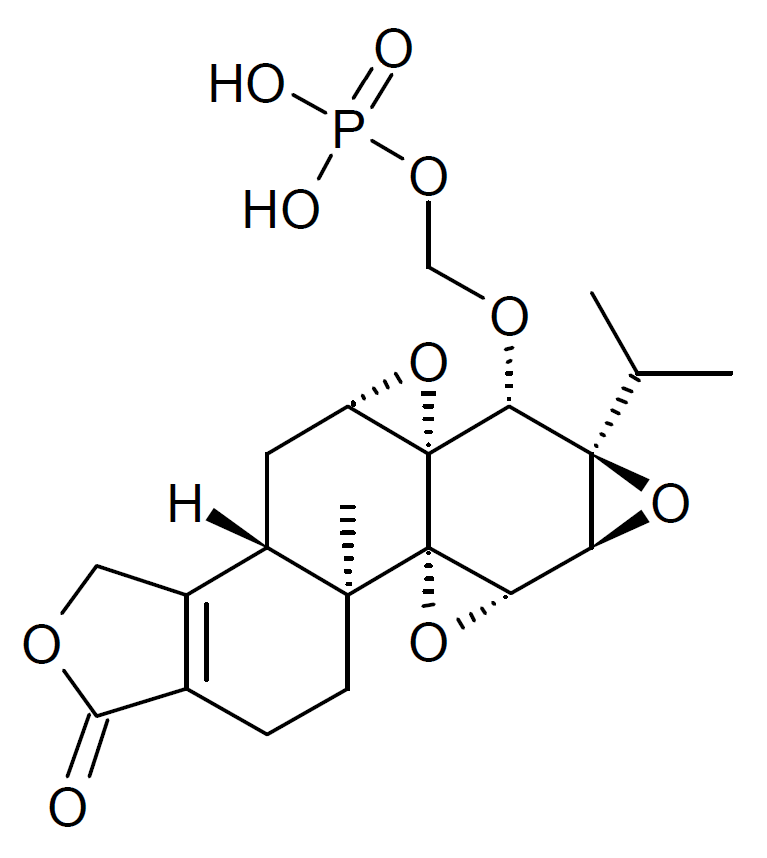Triptolide on:
[Wikipedia]
[Google]
[Amazon]
Triptolide is a diterpenoid epoxide which is produced by the thunder god vine, '' Tripterygium wilfordii''. It has ''
/ref> In a preclinical mouse model of pancreatic cancer, it was "even more effective than gemcitabine". Its Phase II clinical trials are expected to conclude in February 2019. Glutriptolide, a glucose conjugate of triptolide with better solubility and lower toxicity, did not inhibit XPB activity ''in vitro'', but exhibited tumor control ''in vivo'', which is likely due to sustained stepwise release of active triptolide within cancer cells. A second generation glutriptolide has been recently reported for targeting hypoxic cancer cells with increased glucose transporter expression.
Glutriptolide, a glucose conjugate of triptolide with better solubility and lower toxicity, did not inhibit XPB activity ''in vitro'', but exhibited tumor control ''in vivo'', which is likely due to sustained stepwise release of active triptolide within cancer cells. A second generation glutriptolide has been recently reported for targeting hypoxic cancer cells with increased glucose transporter expression.
in vitro
''In vitro'' (meaning ''in glass'', or ''in the glass'') Research, studies are performed with Cell (biology), cells or biological molecules outside their normal biological context. Colloquially called "test-tube experiments", these studies in ...
'' and ''in vivo
Studies that are ''in vivo'' (Latin for "within the living"; often not italicized in English) are those in which the effects of various biological entities are tested on whole, living organisms or cells, usually animals, including humans, an ...
'' activities against mouse models of polycystic kidney disease and pancreatic cancer
Pancreatic cancer arises when cell (biology), cells in the pancreas, a glandular organ behind the stomach, begin to multiply out of control and form a Neoplasm, mass. These cancerous cells have the malignant, ability to invade other parts of ...
, but its physical properties and severe toxicity limit its therapeutic potential. Consequently, a synthetic water-soluble prodrug
A prodrug is a pharmacologically inactive medication or compound that, after intake, is metabolized (i.e., converted within the body) into a pharmacologically active drug. Instead of administering a drug directly, a corresponding prodrug can be ...
, minnelide, is being studied clinically instead.
Triptolide is a component of ContraPest, a contraceptive pest control
Pest control is the regulation or management of a species defined as a pest (organism), pest; such as any animal, plant or fungus that impacts adversely on human activities or environment. The human response depends on the importance of the da ...
liquid used to reduce rat populations in the United States.
Mechanism of action
Several putative target proteins of triptolide have been reported, including polycystin-2, ADAM10, DCTPP1, TAB1, and XPB. Multiple triptolide-resistant mutations exist in XPB (ERCC3) and its partner protein GTF2H4.Y. Smurnyy, M. Cai, H. Wu, E. McWhinnie, J. A. Tallarico, Y.Yang, Y. Feng, DNA sequencing and CRISPR-Cas9 gene editing for target validation in mammalian cells. ''Nat. Chem. Biol''. 2014, 10, 623 – 625 However, no triptolide-resistant mutations were found in polycystin-2, ADAM10, DCTPP1 and TAB1. Cys342 of XPB was identified as the residue that undergoes covalent modification by the 12,13-epoxide group of triptolide, and the XPB-C342T mutant rendered the T7115 cell line nearly completely resistant to triptolide.Q. L. He, D. V. Titov, J. Li, M. Tan, Z. Ye, Y. Zhao, D. Romo, and J. O. Liu. Covalent Modification of a Cysteine Residue in the XPB Subunit of the General Transcription Factor TFIIH Through Single Epoxide Cleavage of the Transcription Inhibitor Triptolide. ''Angew. Chem. Int. Ed.'' 2015, 54, 1859 –1863 The level of resistance conferred by the C342T mutation is about 100-fold higher than the most triptolide-resistant mutants previously identified. Together, these results validate XPB as a target responsible for the antiproliferative activity of triptolide. The disruption of super-enhancer networks has also been suggested as a mechanism of action.Water-soluble prodrugs
Minnelide is a more water-soluble syntheticprodrug
A prodrug is a pharmacologically inactive medication or compound that, after intake, is metabolized (i.e., converted within the body) into a pharmacologically active drug. Instead of administering a drug directly, a corresponding prodrug can be ...
of triptolide which is converted to triptolide ''in vivo
Studies that are ''in vivo'' (Latin for "within the living"; often not italicized in English) are those in which the effects of various biological entities are tested on whole, living organisms or cells, usually animals, including humans, an ...
''.Thunder God Vine Drug Zaps Pancreatic Cancer. GenEng. 2012/ref> In a preclinical mouse model of pancreatic cancer, it was "even more effective than gemcitabine". Its Phase II clinical trials are expected to conclude in February 2019.
 Glutriptolide, a glucose conjugate of triptolide with better solubility and lower toxicity, did not inhibit XPB activity ''in vitro'', but exhibited tumor control ''in vivo'', which is likely due to sustained stepwise release of active triptolide within cancer cells. A second generation glutriptolide has been recently reported for targeting hypoxic cancer cells with increased glucose transporter expression.
Glutriptolide, a glucose conjugate of triptolide with better solubility and lower toxicity, did not inhibit XPB activity ''in vitro'', but exhibited tumor control ''in vivo'', which is likely due to sustained stepwise release of active triptolide within cancer cells. A second generation glutriptolide has been recently reported for targeting hypoxic cancer cells with increased glucose transporter expression.
References
{{Expand German, Triptolid, date=October 2012 Diterpenes Epoxides Furanones Secondary alcohols Isopropyl compounds Plant toxins